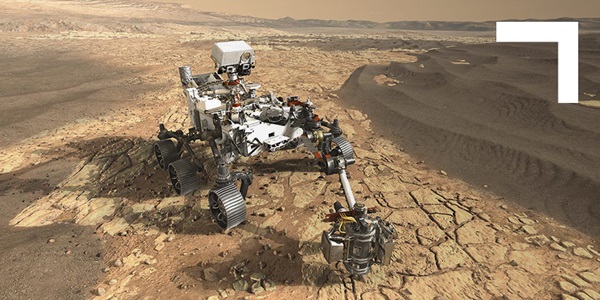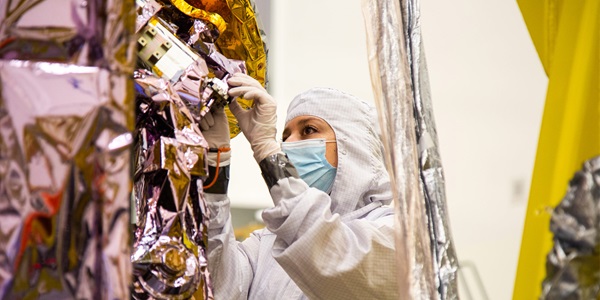Engineering Marvel


By Albert McKeon
Imagine having to squeeze an enormous mirror and a sunshield that's the size of a tennis court into a rocket ship. If that seems improbable, also imagine pulling them out of a capsule and slowly unfolding both in outer space — without the aid of gravity and while contending with punishing temperatures.
This is the reality of an intricate deployment process that NASA and Northrop Grumman engineers have incorporated into the construction of the James Webb Space Telescope, the world's most powerful space telescope.
Instead of building a larger launcher that could simply carry the telescope into space, the engineers created an origami-styled observatory that can be neatly folded inside a conventional rocket and then unfolded once in space. Webb comprises 18 hexagonal sections that stretch over 21 feet in diameter and work together to form a single mirror. Protecting the mirror from the heat and light of the sun, Earth and moon is the five-layered sunshield, a unique engineering feat that will shape the success of perhaps the most unique exploration of space.

The Epic Choreography of the James Webb Telescope Sunshield
Webb is scheduled to launch in 2021. An Ariane 5 rocket will ferry the telescope toward Lagrange Point 2 (L2) almost a million miles away from Earth. From there, the telescope will use the some of the most sophisticated optical technology ever attached to a spacecraft. Sensitive cameras and the big mirror will observe mostly in the infrared range of the electromagnetic spectrum, the better to detect faint objects in the early universe, see through obscuring gases and dust, as well as study the chemical signatures of planet atmospheres in our Solar System and those of exoplanets as well.
Marc Roth, a senior Northrop Grumman engineer on Webb oversees important mechanical aspects that deploy the sunshield, layer by layer, into the same position it will take when it is a million miles from Earth. A particular function that required epic proportions of ingenuity: ensuring the sunshield unfolds precisely to the right position to protect the telescopes mirror and instruments and block light emanating from the sun, Earth and moon. For the telescope to observe the infrared light from distant objects, it has to stay cold, as in 380 degrees Fahrenheit below zero kind of cold.
Roth and his team oversee a pulley system that tugs the five membrane layers of the sunshield into its full form. The layers will initially be stacked on top of one another, squeezing inside the 16-foot fairing of the Ariane 5 rocket along with the attached mirror. But once on its journey, motors will slowly push out booms that will gently spread the shield's layers into a kind of parasol. This high-tech umbrella will provide thermal isolation to keep the telescope side of Webb unbearably — but necessarily — cold by reflecting away heat from the sun, Earth and moon. (The sunny side of the telescope will experience temperatures as high as 230 degrees F.)
"They'll be rewriting textbooks and including new insights based on the data collected from this telescope."
— Marc Roth, Senior Northrop Grumman Engineer
In the vacuum of space, parts move easily at zero gravity. At the Northrop Grumman Space Park facility in Redondo Beach, California, engineers tested the pulley structure against 1G, the force of Earth's gravity, and successfully extended all five of the sunshield's membrane layers (each layer is as thin as a human hair) for the last time on Earth.
“It’s definitely a treat to watch the sunshield’s layers take their final positions,” Roth said. “The membrane tensioning system pulls and tensions each layer of the sunshield, physically separating the five layers from the bottom up in a synchronized sequence. The sunshield keeps Webb cold and stable and is just one of the examples of complex engineering on this incredible observatory."

Searching for Beginnings and Unknown Worlds
Webb is the scientific successor to the Hubble Space Telescope, launched in 1990. The sunshield will protect the 6.5-meter diameter primary mirror, which has over 6 times more collecting area than its predecessor and a significantly larger field of view than the NICMOS near infrared camera on Hubble (covering more than 15 times the area).
Webb will extend and complement the discoveries of Hubble to peer back to the first galaxies and early universe, unveiling a connection between the Big Bang and our galaxy.
"They'll be rewriting textbooks and including new insights based on the data collected from this telescope," said Roth.
Photo credits: Northrop Grumman and NASA/Chris Gunn. Main image taken from the documentary Into the Unknown.
More Innovation Stories
Read all stories about advanced technology and innovation >>


